Popular categories
Looking for a yarn?

75% Mohair, 25% Silk
from 5.55 € /25g
Order DROPS Kid-Silk from Igla i kukica

|
DROPS Kid-Silk uni colour 75% Mohair, 25% Silk |
5.55 € /25g |
Order |
Clicking the ORDER button will redirect you to Igla i kukica website
Order DROPS Needles & Hooks
Clicking the ORDER button will redirect you to Igla i kukica website
The yarn cost is calculated from the pattern’s smallest size and the yarn’s cheapest product type. Looking for an even better price? You might find it on the DROPS Deals!
Sahara Rose Sweater
Knitted jumper in 2 strands DROPS Kid-Silk. The piece is worked top down with stripes and round yoke. Sizes S - XXXL.
DROPS Design: Pattern no ks-164
Yarn group A + A or C
-------------------------------------------------------
SIZES:
S - M - L - XL - XXL - XXXL
MATERIALS:
DROPS KID-SILK from Garnstudio (belongs to yarn group A)
75-100-100-100-125-125 g colour 01, off white
50-75-75-75-75-100 g colour 12, beige
25-50-50-50-50-50 g colour 20, light beige
KNITTING TENSION:
17 stitches in width and 22 rows in height with stocking stitch and 2 strands = 10 x 10 cm.
NEEDLES:
DROPS DOUBLE POINTED NEEDLES SIZE 5 MM.
DROPS CIRCULAR NEEDLE SIZE 5 MM: Length 40 cm and 80 cm for stocking stitch.
DROPS DOUBLE POINTED NEEDLES SIZE 4 MM.
DROPS CIRCULAR NEEDLE SIZE 4 MM: Length 40 cm and 80 cm for rib.
Needle size is only a guide. If you get too many stitches on 10 cm, change to a larger needle size. If you get too few stitches on 10 cm, change to a smaller needle size.
-------------------------------------------------------
Alternative Yarn – See how to change yarns here
Yarn Groups A to F – Use the same pattern and change the yarn here
Yarn usage using an alternative yarn – Use our yarn converter here
-------------------------------------------------------

75% Mohair, 25% Silk
from 5.55 € /25g
Order DROPS Kid-Silk from Igla i kukica

|
DROPS Kid-Silk uni colour 75% Mohair, 25% Silk 5.55 € /25g Order |
Clicking the ORDER button will redirect you to Igla i kukica website
Order DROPS Needles & Hooks
Clicking the ORDER button will redirect you to Igla i kukica website
The yarn cost is calculated from the pattern’s smallest size and the yarn’s cheapest product type. Looking for an even better price? You might find it on the DROPS Deals!
- English (UK/cm), Croatia
- Česky
- Dansk
- Deutsch
- Eesti keel
- English (UK/cm)
- English (US/in)
- Español
- Français
- Íslenska
- Italiano
- Magyar
- Nederlands
- Norsk
- Polski
- Português
- Suomi
- Svenska
- English (UK/cm), Bulgaria
- English (UK/cm), Greece
- English (UK/cm), Latvia
- English (UK/cm), Lithuania
- English (UK/cm), Romania
- English (UK/cm), Slovenia
- Česky, Slovakia
Pattern instructions
EXPLANATIONS FOR THE PATTERN:
-------------------------------------------------------
STRIPES:
NOTE: Stripes start on the yoke (after the rib).
STRIPE 1: 5-5-5-5-6-6 cm with 1 strand light beige + 1 strand off white (+ 3 cm of rib = a total of 8-8-8-8-9-9 cm).
STRIPE 2: 7-8-8-8-8-8 cm with 2 strands off white.
STRIPE 3: 2-2-2-2-2-2 cm (i.e. 4 rows) with 1 strand off white + 1 strand beige.
STRIPE 4: 5-5-5-6-6-7 cm with 2 strands beige.
STRIPE 5: 7-8-8-8-8-8 cm with 1 strand light beige + 1 strand off white.
STRIPE 6: 2-2-2-2-2-2 cm (i.e. 4 rows) with 1 strand beige + 1 strand off white.
STRIPE 7: 7-7-8-8-8-8 cm with 2 strands light beige.
STRIPE 8: 5-5-5-6-6-7 cm with 2 strands off white.
STRIPE 9: Work with 2 strands beige to finished length (approx. 5-5-6-6-7-7 cm).
STRIPES SLEEVE:
Continue with stripes in the same way as on the body until stripe 7 has been completed in height. Then work with 2 strands off white until the sleeve measures 32-31-29-28-26-25 cm. Finally work with 2 strands beige to finished length.
INCREASE/DECREASE TIP (evenly spaced):
To work out how to increase/decrease evenly, count the total number of stitches on needle (e.g. 80 stitches) and divide by the number of increases/decreases to be made (e.g. 2) = 40. In this example, increase by making 1 yarn over after each 40th stitch. On the next round work the yarn overs twisted to avoid holes. When decreasing, knit together each 39th and 40th stitch.
INCREASE TIP (for yoke):
Increase alternately before and after the marker thread; i.e. first increase before all marker threads on the round, then increase after all marker threads, then increase before all marker threads and so-on.
Increase before the marker thread as follows: Work until there is 1 stitch left before the marker thread and make 1 yarn over, knit 1, marker thread sits here.
Increase after the marker thread as follows: Knit 2, make 1 yarn over.
On the next round knit the yarn overs twisted to avoid holes. Then work the new stitches in stocking stitch.
DECREASE TIP (for sleeves):
Decrease 1 stitch on each side of the marker thread as follows: Work until there are 3 stitches left before the marker thread, knit 2 together, knit 2 (marker thread sits between these 2 stitches), slip 1 stitch as if to knit, knit 1 and pass the slipped stitch over the knitted stitch.
CASTING-OFF TIP:
To avoid the cast-off edge being tight you can cast off with a larger size needle. If the edge is still tight, make 1 yarn over after approx. each 4th stitch at the same time as casting off and the yarn overs are cast off as normal stitches.
-------------------------------------------------------
START THE PIECE HERE:
-------------------------------------------------------
JUMPER – SHORT OVERVIEW OF THE PIECE:
The neck and yoke are worked in the round with circular needle, top down from mid back. The yoke is divided for body and sleeves and the body continued in the round with circular needle. The sleeves are worked in the round with short circular needle/double pointed needles, top down.
NECK:
Cast on 80-84-88-92-96-100 stitches with circular needle size 4 mm and 1 strand off-white + 1 strand light beige (= 2 strands). Knit 1 round. Then work rib (= knit 2 / purl 2) in the round for 3 cm. Knit 1 round where the number of stitches is adjusted to 78-84-90-96-102-108 stitches – read INCREASE/DECREASE TIP (i.e., in size S decrease 2 stitches, in size M the stitch-number stays the same and in sizes L, XL, XXL and XXXL increase 2-4-6-8 stitches). Insert a marker at the beginning of the round (= mid back). THE PIECE IS NOW MEASURED FROM HERE.
YOKE:
Change to circular needle size 5 mm. The first round on the yoke is worked as follows: * Knit 3, insert a marker thread here, knit 3 *, work from *-* to the end of the round = 13-14-15-16-17-18 marker threads in the piece. Allow the threads to follow your work onwards; they will be used when increasing on the yoke.
Work stocking stitch and STRIPES – read description above. AT THE SAME TIME, on the first round, increase at each of the marker threads – read INCREASE TIP. Increase like this every 2nd round 3-3-6-5-4-3 times and every 4th-4th-6th-6th-6th-6th round 9-9-6-7-8-9 times = 234-252-270-288-306-324 stitches. REMEMBER THE KNITTING TENSION!
When all the increases are finished knit 1 round where you increase 0-2-6-6-12-14 stitches evenly spaced = 234-254-276-294-318-338 stitches. Continue with stocking stitch until the piece measures 21-23-25-27-29-31 cm from the marker.
The next round is worked as follows: Work the first 33-36-39-42-46-50 stitches (= half back piece), place the next 51-55-59-63-67-68 stitches on a thread and cast on 8-8-8-10-10-12 stitches on the needle (= in side under the sleeve), work the next 66-72-79-84-92-101 stitches (= front piece), place the next 51-55-59-63-67-68 stitches on a thread and cast on 8-8-8-10-10-12 stitches on the needle (= in side under the sleeve), work the last 33-36-40-42-46-51 stitches (= half back piece). Body and sleeves are finished separately. THE PIECE IS NOW MEASURED FROM HERE.
BODY:
= 148-160-174-188-204-226 stitches. Continue in the round with stocking stitch and stripes. When the piece measures 20 cm, knit 1 round where you increase 28-32-34-40-40-46 stitches = 176-192-208-228-244-272 stitches. Change to circular needle size 4 mm and work rib (= knit 2 / purl 2) for 4 cm. Cast off with knit over knit and purl over purl – read CASTING-OFF TIP. The jumper measures approx. 49-51-53-55-57-59 cm from the shoulder down.
SLEEVE:
Place the 51-55-59-63-67-68 stitches from the thread on the one side of the piece on short circular needle/double pointed needles size 5 mm and knit up 1 stitch in each of the 8-8-8-10-10-12 stitches cast on under the sleeve = 59-63-67-73-77-80 stitches. Insert a marker thread in the middle of the 8-8-8-10-10-12 stitches under the sleeve (= 4-4-4-5-5-6 new stitches on each side of the marker thread). Allow the thread to follow your work onwards; it will be used when decreasing under the sleeve. Work stocking stitch and STRIPES SLEEVE. When the sleeve measures 4-4-4-4-4-3 cm from the division begin to decrease – read DECREASE TIP. Decrease like this every 6½-4-3-2½-2-2 cm a total of 5-7-8-10-11-12 times = 49-49-51-53-55-56 stitches. Continue working until the sleeve measures 33-32-30-29-27-26 cm from the division. Knit 1 round where you decrease 9-9-7-5-7-8 stitches evenly spaced = 40-40-44-48-48-48 stitches. Change to double pointed needles size 4 mm and work rib (= knit 2 / purl 2) for 5 cm. Cast off with knit over knit and purl over purl – remember CASTING-OFF TIP. Work the other sleeve in the same way.
Diagram
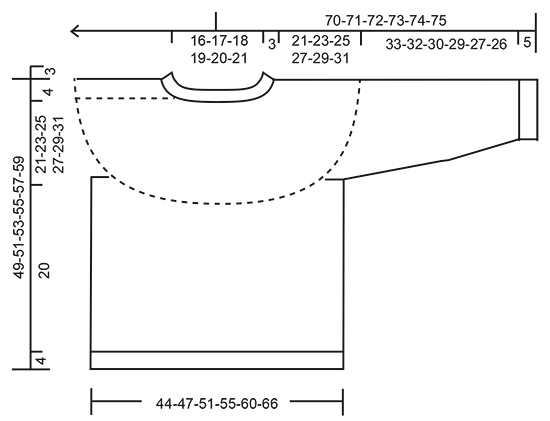
What can you do with our patterns? You can share DROPS patterns online, using the pattern original picture, materials, name and number. But you are NOT ALLOWED to reproduce the complete pattern digitally in any way. Yarn stores are welcome to use the DROPS pattern database to promote the sale of our assortment. You can print out our patterns, make as many copies as you’d like. The only thing we ask is that you don't make any changes / additions to the original printed document. And that the patterns according to the DROPS philosophy are given out to the consumers for free. Editorials that wish to publish our patterns in printed books or magazines can contact us for more information. The sale of garments based on DROPS patterns is permitted as long as they are sold as single items or per order. Further commercial use of the patterns is not permitted. It has to be clearly stated that the garment is made based on a design from DROPS DESIGN. The use of clothing labels of which DROPS DESIGN forms part is conditioned by the inclusion of the following text: “A DROPS DESIGN made by …..”. The use of DROPS photos for marketing purposes/sales is only permitted in connection with the use/sale of DROPS products. The photos may not be cut or edited and the logo should be clearly visible.
We reserve the right to withdraw the permission for use of our patterns at any time, notwithstanding the reason.
Each of our patterns has specific tutorial videos to help you.
These step-by-step tutorials might also help you:
Why is the knitting/crochet tension so important?
Knitting tension is what determines the final measurements of your work, and is usually measured per 10 x 10 cm. It is provided like so: number of stitches in width x number of rows in height - eg: 19 stitches x 26 rows = 10 x 10 cm.
The knitting tension is very individual; some people knit/crochet loosely while others work tightly. You adjust the knitting tension with the needle size, which is why the suggested needle size is only meant as a guide! You need to adjust this (up or down) to ensure that YOUR knitting tension matches the knitting tension provided in the pattern. If you work with a different knitting tension than provided you will have a different yarn consumption, and your work will have different measurements than what the pattern suggests.
The knitting tension also determines which yarns can replace each other. As long as you achieve the same knitting tension you can replace one yarn with another.
See DROPS lesson: How to measure your tension/gauge
See DROPS video: How to make a gauge tension swatch
How do I know how many balls of yarn I need?
The required amount of yarn is provided in grams, eg: 450 g. To calculate how many balls you’ll need you first need to know how many grams are in 1 ball (25g, 50g or 100g). This information is available if you click on the individual yarn quality on our pages. Divide the amount required with the amount of each ball. For example, if each ball is 50g (the most common amount), the calculation will be as follows: 450 / 50 = 9 balls.
Can I use a different yarn than what the pattern suggests?
The important thing when changing from one yarn to another is that the knitting/crochet tension remains the same. This is so that the measurements of the finished piece will be the same as on the sketch provided. It is easier to achieve the same knitting tension using yarns from the same yarn group. It is also possible to work with multiple strands of a thinner yarn to achieve the knitting tension of a thicker one. Please try our yarn converter. We recommend you to always work a test swatch.
Please NOTE: when changing yarn the garment might have a different look and feel to the garment in the photo, due to individual properties and qualities of each yarn.
See DROPS lesson: Can I use a different yarn than the one mentioned in the pattern?
What are the yarn groups?
All our yarns are categorised into yarn groups (from A to F) according to thickness and knitting tension – group A contains the thinnest yarns and group F the thickest. This makes it easier for you to find alternative yarns to our patterns, should you wish to switch yarn. All yarns within the same group have a similar knitting tension and can easily replace each other. However, different yarn qualities have different structures and properties which will give the finished work a unique look and feel.
How do I use the yarn calculator?
At the top of all our patterns you’ll find a link to our yarn calculator, which is a helpful tool should you wish to use a different yarn than suggested. By filling in the yarn quality you wish to replace, the amount (in your size) and number of strands, the calculator will present good alternative yarns with the same knitting tension. Additionally it will tell you how much you’ll require in the new qualities and whether you’ll need to work with multiple strands. Most skeins are 50g (some are 25g or 100g).
If the pattern is worked with multiple colours, every colour will have to be calculated separately. Similarly, if the pattern is worked with several strands of different yarns (for example 1 strand Alpaca and 1 strand Kid-Silk) you will have to find alternatives for each, individually.
Why do you show discontinued yarns in the patterns?
Since different yarns have different qualities and textures we have chosen to keep the original yarn in our patterns. However, you can easily find options among our available qualities by using our yarn calculator, or simply pick a yarn from the same yarn group.
It is possible that some retailers still have discontinued yarns in stock, or that someone has a few skeins at home that they would like to find patterns for.
The yarn calculator will provide both alternative yarn as well as required amount in the new quality.
What size should I knit?
If you think it's hard to decide what size to make, it can be a good idea to measure a garment you own already and like the size of. Then you can pick the size by comparing those measures with the ones available in the pattern's size chart.
You'll find the size chart at the bottom of the pattern.
See DROPS lesson: How to read size chart
Why do I get the wrong knitting tension with the suggested needle size?
The needle size provided in the pattern serves only as a guide, the important thing is to follow the knitting tension. And since knitting tension is very individual, you will have to adjust the needle size to ensure that YOUR tension is the same as in the pattern – maybe you’ll have to adjust 1, or even 2 needle sizes, up or down to achieve the correct tension. For this, we recommend that you work test swatches.
Should you work with a different knitting tension than the one provided, the measurements of the finished garment might deviate from the measurement sketch.
See DROPS lesson: How to measure your tension/gauge
See DROPS video: How to make a tension/gauge swatch
Why is the pattern worked top-down?
Working a garment top-down provides more flexibility and room for personal adjustment. For example it is easier to try the garment on while working, as well as making adjustments to length of yoke and shoulder caps.
The instructions are carefully explaining every step, in the correct order. Diagrams are adjusted to the knitting direction and are worked as usual.
How do I work according to a knitting diagram?
The diagram depicts all rows/rounds, and every stitch seen from the right side. It is read from bottom to top, from right to left. 1 square = 1 stitch.
When working back and forth, every other row is worked from the right side and every other row is worked from the wrong side. When working from the wrong side, the diagram will have to be worked reversed: from left to right, knit stitches are purled, purl stitches are knit etc.
When working in the round every round is worked from the right side and the diagram are worked from right to left on all rounds.
See DROPS lesson: How to read knitting diagrams
How do I work according to a crochet diagram?
The diagram depicts all rows/rounds, and every stitch seen from the right side. It is worked from bottom to top, from right to left.
When working back and forth every other row is worked from the right side: from right to left and every other row is worked from the wrong side: from left to right.
When working in the round, every row in the diagram are worked from the right side, from right to left.
When working a circular diagram you start in the middle and work your way outwards, counter clockwise, row by row.
The rows usually start with a given number of chain stitches (equivalent to the height of the following stitch), this will either be depicted in the diagram or explained in the pattern.
See DROPS lesson: How to read crochet diagrams
How do I work several diagrams simultaneously on the same row/round?
Instructions for working several diagrams after each other on the same row/round, will often be written like so: “work A.1, A.2, A.3 a total of 0-0-2-3-4 times". This means you work A.1 once, then A.2 is worked once, and A.3 is repeated (in width) the number of times provided for your size – in this case like so: S = 0 times, M = 0 times, L=2 times, XL= 3 times and XXL = 4 times.
The diagrams are worked as usual: begin with the first row in A.1, then work the first row in A.2 etc.
See DROPS lesson: How to read knitting diagrams
See DROPS lesson: How to read crochet diagrams
Why are the sleeves shorter in larger sizes?
The total width of the garment (from wrist-to-wrist) will be larger in the larger sizes, despite the actual sleeves being shorter. The larger sizes have longer sleeve caps and wider shoulders, so there will be a good fit in all sizes.
Where on the garment is the length measured?
The measurement sketch/schematic drawing provides information regarding the full length of the garment. If it’s a jumper or a jacket the length is measured from the highest point on the shoulder closest to the neckline, and straight down to the bottom of the garment. It is NOT measured from the tip of shoulder. Similarly, the length of yoke is measured from the highest point on the shoulder and down to where yoke is split into body and sleeves.
On a jacket measures are never taken along bands, unless specifically stated. Always measure inside band stitches when measuring the length.
See DROPS lesson: How to read a schematic drawing
What is a repeat?
Diagrams are often repeated on the round or in height. 1 repeat is the diagram the way it appears in the pattern. If it says to work 5 repeats of A.1 in the round, then you work A.1 a total of 5 times after/next to each other in the round. If it says to work 2 repeats of A.1 vertically/in height you work the entire diagram once, then begin again at the start and work the entire diagram one more time.
Why does the piece start with more chain stitches than it’s worked with?
Chain stitches are slightly narrower than other stitches and to avoid working the cast-on edge too tight, we simply chain more stitches to begin with. The stitch count will be adjusted on the following row to fit the pattern and measurement sketch.
Why increase before the rib edge when the piece is worked top-down?
The rib edge is more elastic and will contract slightly compared to, for example, stocking stitch. By increasing before the rib edge, you avoid a visible difference in width between the rib edge and the rest of the body.
Why increase in the cast-off edge?
It’s very easy to cast off too tightly, and by making yarn overs while casting off (and simultaneously casting these off) you avoid a too tight cast off edge.
See DROPS video: How to bind off with yarn overs (yo)
How do I increase/decrease on every 3rd and 4th row/round alternately?
To achieve an even increase (or decrease) you can increase on, for example: every 3rd and 4th row alternately, like so: work 2 rows and increase on the 3rd row, work 3 rows and increase on the 4th. Repeat this until the increase is complete.
See DROPS lesson: Increase or decrease 1 st on every 3rd and 4th row alternately
How can I work a jacket in the round instead of back and forth?
Should you prefer to work in the round instead of back and forth, you may of course adjust the pattern. You’ll need to add steeks mid-front (usually 5 stitches), and follow the instructions. When you would normally turn and work from the wrong side, simply work across the steek and continue in the round. At the end you’ll cut the piece open, pick up stitches to work bands, and cover the cut edges.
See DROPS video: How to knit steeks and cut open
Can I work a jumper back and forth instead of in the round?
Should you prefer to work back and forth instead of in the round, you may of course adjust the pattern so you work the pieces separately and then assemble them at the end. Divide the stitches for the body in 2, add 1 edge stitch in each side (for sewing) and work the front and back pieces separately.
See DROPS lesson: Can I adapt a pattern for circular needles into straight needles?
Why is the pattern slightly different than what I see in the photo?
Pattern repeats can vary slightly in the different sizes, in order to get the correct proportions. If you’re not working the exact same size as the garment in the photo, yours might deviate slightly. This has been carefully developed and adjusted so that the complete impression of the garment is the same in all sizes.
Make sure to follow instructions and diagrams for your size!
How do I make a women’s size garment into a men’s size one?
If you have found a pattern you like which is available in women’s size it’s not very difficult to convert it to men’s size. The biggest difference will be the length of sleeves and body. Start working on the women size that you think would fit across the chest. The additional length will be worked right before you cast off for the armhole/sleeve cap. If the pattern is worked top-down you can add the length right after the armhole or before the first decrease on sleeve.
Regarding additional yarn amount, this will depend on how much length you add, but it is better with a skein too many than too few.
How do I prevent a hairy garment from shedding?
All yarns will have excess fibres (from production) that might come off as lint or shedding. Brushed yarns (ie hairier yarns) have more of these loose, excess fibres, causing more shedding.
Shedding also depends on what is worn under or over the garment, and whether this pulls at the yarn fibres. It’s therefore not possible to guarantee that there will be no shedding
Below are some tips on how to get the best result when working with hairier yarns:
1. When the garment is finished (before you wash it) shake it vigorously so the looser hairs come off. NOTE: do NOT use a lint roller, brush or any method that pulls at the yarn.
2. Place the garment in a plastic bag and put it in your freezer - the temperature will cause the fibres to become less attached to each other, and excess fibres will come off easier.
3. Leave in the freezer for a few hours before taking it out and shaking it again.
4. Wash the garment according to the instructions on the yarn label.
Why does my garment pill?
Pilling is a natural process that happens to even the most exclusive of fibers. It's a natural sign of wear and tear that is hard to avoid, and that is most visible in high friction areas of your garment like a sweater's arms and cuffs.
You can make your garment look as new by removing the pilling, using a fabric comb or a pill/lint remover.
In the meantime, you can read the questions and answers that others have left to this pattern or join the DROPS Workshop on Facebook to get help from fellow knitters/crocheters!
You might also like...
Sahara Rose Sweater |
|
 |
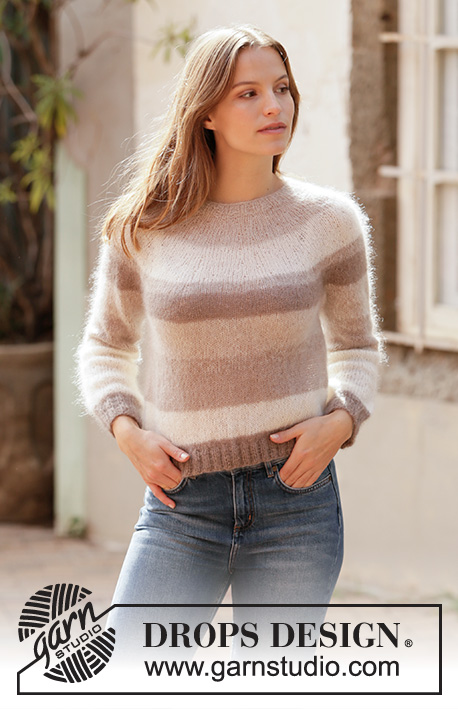 |
Knitted jumper in 2 strands DROPS Kid-Silk. The piece is worked top down with stripes and round yoke. Sizes S - XXXL.
DROPS 213-32 |
|
|
------------------------------------------------------- EXPLANATIONS FOR THE PATTERN: ------------------------------------------------------- STRIPES: NOTE: Stripes start on the yoke (after the rib). STRIPE 1: 5-5-5-5-6-6 cm with 1 strand light beige + 1 strand off white (+ 3 cm of rib = a total of 8-8-8-8-9-9 cm). STRIPE 2: 7-8-8-8-8-8 cm with 2 strands off white. STRIPE 3: 2-2-2-2-2-2 cm (i.e. 4 rows) with 1 strand off white + 1 strand beige. STRIPE 4: 5-5-5-6-6-7 cm with 2 strands beige. STRIPE 5: 7-8-8-8-8-8 cm with 1 strand light beige + 1 strand off white. STRIPE 6: 2-2-2-2-2-2 cm (i.e. 4 rows) with 1 strand beige + 1 strand off white. STRIPE 7: 7-7-8-8-8-8 cm with 2 strands light beige. STRIPE 8: 5-5-5-6-6-7 cm with 2 strands off white. STRIPE 9: Work with 2 strands beige to finished length (approx. 5-5-6-6-7-7 cm). STRIPES SLEEVE: Continue with stripes in the same way as on the body until stripe 7 has been completed in height. Then work with 2 strands off white until the sleeve measures 32-31-29-28-26-25 cm. Finally work with 2 strands beige to finished length. INCREASE/DECREASE TIP (evenly spaced): To work out how to increase/decrease evenly, count the total number of stitches on needle (e.g. 80 stitches) and divide by the number of increases/decreases to be made (e.g. 2) = 40. In this example, increase by making 1 yarn over after each 40th stitch. On the next round work the yarn overs twisted to avoid holes. When decreasing, knit together each 39th and 40th stitch. INCREASE TIP (for yoke): Increase alternately before and after the marker thread; i.e. first increase before all marker threads on the round, then increase after all marker threads, then increase before all marker threads and so-on. Increase before the marker thread as follows: Work until there is 1 stitch left before the marker thread and make 1 yarn over, knit 1, marker thread sits here. Increase after the marker thread as follows: Knit 2, make 1 yarn over. On the next round knit the yarn overs twisted to avoid holes. Then work the new stitches in stocking stitch. DECREASE TIP (for sleeves): Decrease 1 stitch on each side of the marker thread as follows: Work until there are 3 stitches left before the marker thread, knit 2 together, knit 2 (marker thread sits between these 2 stitches), slip 1 stitch as if to knit, knit 1 and pass the slipped stitch over the knitted stitch. CASTING-OFF TIP: To avoid the cast-off edge being tight you can cast off with a larger size needle. If the edge is still tight, make 1 yarn over after approx. each 4th stitch at the same time as casting off and the yarn overs are cast off as normal stitches. ------------------------------------------------------- START THE PIECE HERE: ------------------------------------------------------- JUMPER – SHORT OVERVIEW OF THE PIECE: The neck and yoke are worked in the round with circular needle, top down from mid back. The yoke is divided for body and sleeves and the body continued in the round with circular needle. The sleeves are worked in the round with short circular needle/double pointed needles, top down. NECK: Cast on 80-84-88-92-96-100 stitches with circular needle size 4 mm and 1 strand off-white + 1 strand light beige (= 2 strands). Knit 1 round. Then work rib (= knit 2 / purl 2) in the round for 3 cm. Knit 1 round where the number of stitches is adjusted to 78-84-90-96-102-108 stitches – read INCREASE/DECREASE TIP (i.e., in size S decrease 2 stitches, in size M the stitch-number stays the same and in sizes L, XL, XXL and XXXL increase 2-4-6-8 stitches). Insert a marker at the beginning of the round (= mid back). THE PIECE IS NOW MEASURED FROM HERE. YOKE: Change to circular needle size 5 mm. The first round on the yoke is worked as follows: * Knit 3, insert a marker thread here, knit 3 *, work from *-* to the end of the round = 13-14-15-16-17-18 marker threads in the piece. Allow the threads to follow your work onwards; they will be used when increasing on the yoke. Work stocking stitch and STRIPES – read description above. AT THE SAME TIME, on the first round, increase at each of the marker threads – read INCREASE TIP. Increase like this every 2nd round 3-3-6-5-4-3 times and every 4th-4th-6th-6th-6th-6th round 9-9-6-7-8-9 times = 234-252-270-288-306-324 stitches. REMEMBER THE KNITTING TENSION! When all the increases are finished knit 1 round where you increase 0-2-6-6-12-14 stitches evenly spaced = 234-254-276-294-318-338 stitches. Continue with stocking stitch until the piece measures 21-23-25-27-29-31 cm from the marker. The next round is worked as follows: Work the first 33-36-39-42-46-50 stitches (= half back piece), place the next 51-55-59-63-67-68 stitches on a thread and cast on 8-8-8-10-10-12 stitches on the needle (= in side under the sleeve), work the next 66-72-79-84-92-101 stitches (= front piece), place the next 51-55-59-63-67-68 stitches on a thread and cast on 8-8-8-10-10-12 stitches on the needle (= in side under the sleeve), work the last 33-36-40-42-46-51 stitches (= half back piece). Body and sleeves are finished separately. THE PIECE IS NOW MEASURED FROM HERE. BODY: = 148-160-174-188-204-226 stitches. Continue in the round with stocking stitch and stripes. When the piece measures 20 cm, knit 1 round where you increase 28-32-34-40-40-46 stitches = 176-192-208-228-244-272 stitches. Change to circular needle size 4 mm and work rib (= knit 2 / purl 2) for 4 cm. Cast off with knit over knit and purl over purl – read CASTING-OFF TIP. The jumper measures approx. 49-51-53-55-57-59 cm from the shoulder down. SLEEVE: Place the 51-55-59-63-67-68 stitches from the thread on the one side of the piece on short circular needle/double pointed needles size 5 mm and knit up 1 stitch in each of the 8-8-8-10-10-12 stitches cast on under the sleeve = 59-63-67-73-77-80 stitches. Insert a marker thread in the middle of the 8-8-8-10-10-12 stitches under the sleeve (= 4-4-4-5-5-6 new stitches on each side of the marker thread). Allow the thread to follow your work onwards; it will be used when decreasing under the sleeve. Work stocking stitch and STRIPES SLEEVE. When the sleeve measures 4-4-4-4-4-3 cm from the division begin to decrease – read DECREASE TIP. Decrease like this every 6½-4-3-2½-2-2 cm a total of 5-7-8-10-11-12 times = 49-49-51-53-55-56 stitches. Continue working until the sleeve measures 33-32-30-29-27-26 cm from the division. Knit 1 round where you decrease 9-9-7-5-7-8 stitches evenly spaced = 40-40-44-48-48-48 stitches. Change to double pointed needles size 4 mm and work rib (= knit 2 / purl 2) for 5 cm. Cast off with knit over knit and purl over purl – remember CASTING-OFF TIP. Work the other sleeve in the same way. |
|

|
|
|
Have you made this or any other of our designs? Tag your pictures in social media with #dropsdesign so we can see them! Do you need help with this pattern?You'll find tutorial videos, a Comments/Questions area and more by visiting the pattern on garnstudio.com. © 1982-2024 DROPS Design A/S. We reserve all rights. This document, including all its sub-sections, has copyrights. Read more about what you can do with our patterns at the bottom of each pattern on our site. |
|
With over 40 years in knitting and crochet design, DROPS Design offers one of the most extensive collections of free patterns on the internet - translated to 17 languages. As of today we count 304 catalogues and 11422 patterns - 11422 of which are translated into English (UK/cm).
We work hard to bring you the best knitting and crochet have to offer, inspiration and advice as well as great quality yarns at incredible prices! Would you like to use our patterns for other than personal use? You can read what you are allowed to do in the Copyright text at the bottom of all our patterns. Happy crafting!






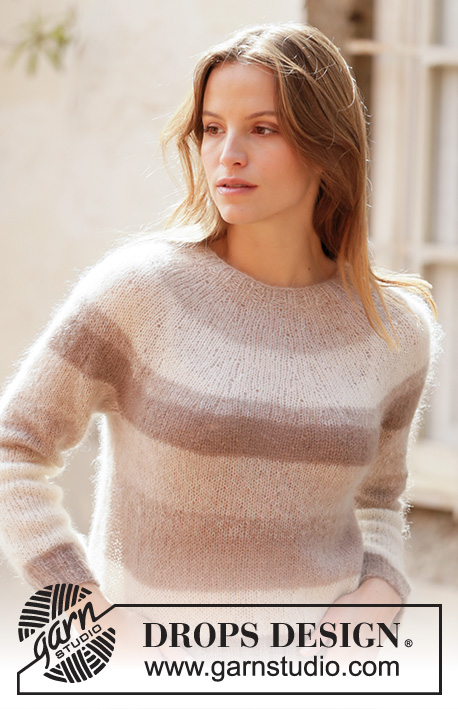

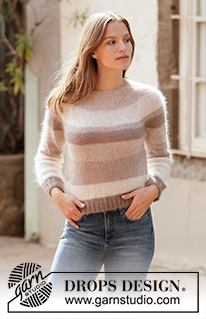
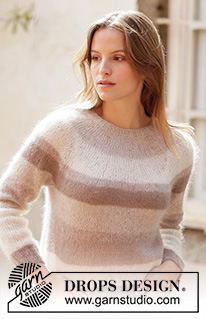









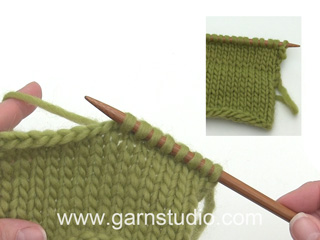








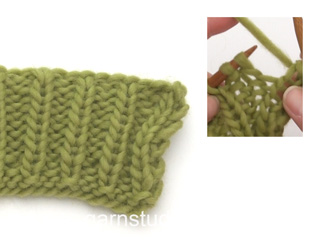






























Comments / Questions (37)
De vorige vraag heb ik via translate opgelost. Nu ben ik bij; brei de eerste 33 (maat S) zet 51 op de hulpdraad en 8 op de naald. Brei 66 steken, 51 op de draad en 8 op de naald, brei 33 steken. 33+51+66+51+33= 234. Ik heb 234 steken. Waar moeten die 2x8 vandaan komen, van de 51 die op de hulpdraad zijn of van de 66 van het voorpand.
07.09.2020 - 14:06DROPS Design answered:
Dag Marga,
Dat zijn 8 nieuwe steken die je opzet. Deze komen als het ware onder de oksel.
13.09.2020 - 11:12Ik maak maat S, hals 80 steken. Dan de pas *3 recht - markeerdraad 3 recht - markeerdraad 3 recht enzovoort. Maar dan kom ik niet tot13 markeerdraden maar 26. Wat doe ik fout?
05.09.2020 - 22:10DROPS Design answered:
Dag Marga,
Er horen steeds 6 steken tussen de markeerdraden te zitten. Eerst brei je 3 steken dan een markeerdraad, dan steeds 6 steken er tussen. Op het eind houd je nog 3 steken over (+ de 3 steken van het begin van de toer.).
11.09.2020 - 13:45Spørsmål i fht økning. Det står at jeg skal sette merketråd etter hver 3.maske og deretter øke rundt disse. Det står videre at jeg da har 17 merketråder i min str. Dette blir selvsagt feil, da 17x3 = 51, ettersom det er 102 masker rundt vil det bli 34 merkestråder. Jeg antar det likevel blir riktig i fht uttak, men spør likevel ettersom det blir dobbelt så mange økninger som det ville blitt med 17 merker?
04.08.2020 - 09:31DROPS Design answered:
Hei Siri. Du skal ikke øke etter hver 3. maske. men etter hver 6. maske MEN du starter med å strikke 3 masker før 1. merketråd skal settes. Slik står det i oppskriften: Strikk * 3 masker rett, sett en merketråd her, strikk 3 masker rett *, strikk fra *-* rundt omgangen = 13-14-15-16-17-18 merketråder i arbeide. Når du gjentar det som står mellom stjernene blir det 6 masker mellom hver merketråd. Du får da 17 merketråder i str XXL med 6 masker mellom = 102 masker på pinnen. God Fornøyelse!
10.08.2020 - 14:35Bonjour, je rencontre un problème dans l'ouvrage, je suis à l'empiècement. J'ai 252 mailles pour le taille M alors que je n'ai augmenté que 3 fois tous les 4 tours, il y a encore 6 fois tous les 4 tours, donc je ne comprend pas. Pouvez vous me venir en aide svp. Merci d'avance
17.07.2020 - 23:41DROPS Design answered:
Bonjour Na Sourya, vous avez 14 fils marqueurs et devez augmenter 14 mailles à chaque fois alternativement avant et après le fil marqueur (cf AUGMENTATIONS), vous avez 84 m + (14 augm x 12) = 252 m. Bon tricot!
20.07.2020 - 09:01Hi I am going to knit this for my daughter but with different colours and don't want to mix the colours only knit in 2 strands of same colours, could you confirm the amount I would need of 3 colts working this was. Much appreciated as I want to buy adequate amount as your wool is not available in /Australia. regards Belinda
04.07.2020 - 01:32DROPS Design answered:
Dear Belinda, we are unfortunately not able to adjust every pattern to every single request - please contact your DROPS store - even per mail or telephone, they should be able to help you - you can also get inspiration from patterns with same tension and stripes. Happy knitting!
06.07.2020 - 08:13I oppskriften 213-32 står det at jeg skal øke masker før vrangborden. Kan det være riktig ?
15.06.2020 - 16:52DROPS Design answered:
Hej Kirsten, ja det stemmer, det gør du fordi du skifter pinde til et nummer mindre og fordi at ribben trækker arbejdet sammen. God fornøjelse!
16.06.2020 - 07:40Hi I have increased for the yoke...3 times and then 9 times. but now I have ended up with 390 for size s
10.06.2020 - 21:51DROPS Design answered:
Dear Selam, did you increase 13 stitches (1 stitch at each marker) on each increase round? You should have 78 sts + 13 inc x 3 (39 inc) + 13 inc x 9 (117 inc) = 234 sts. Happy knitting!
11.06.2020 - 08:31Har kommet så langt i mønster og ferdig med øking. Så står d strikk glsttstrikk til arbeidet måler 25cm fra merket. Hvor måler jeg fra?
18.05.2020 - 09:37DROPS Design answered:
Hei Lena. Siste linje under HALSKANT står det: ..... Sett et merke på begynnelsen av omgangen (= midt bak). HERFRA MÅLES ARBEIDET VIDERE. God Fornøyelse!
18.05.2020 - 12:00Hej! Jag skulle vilja sticka denna fina tröja enfärgad. Finns det någon översikt för garnåtgång/storlek i enfärgad version?
22.04.2020 - 11:39DROPS Design answered:
Hei Lotta. Om du ønsker å strikke denne genseren ensfarget, trenger du denne garnmengden: S (150g) - M (175 g) - L (200 g)- XL (200 g) - XXL (225 g) - XXXL (250 g). God Fornøyelse!
28.04.2020 - 11:34Milk & coffee
07.04.2020 - 13:59